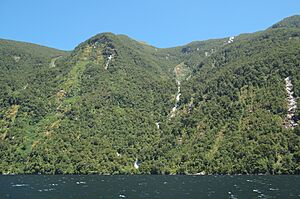Browne Falls facts for kids
Quick facts for kids Browne Falls |
|
|---|---|

Browne Falls in summer with very low water flow
|
|
| Lua error in Module:Infobox_mapframe at line 185: attempt to index field 'wikibase' (a nil value). | |
| Location | Doubtful Sound, New Zealand |
| Type | Cascade |
| Total height | 619 or 836 metres |
| Number of drops | 6 |
| World height ranking | 10 |
Browne Falls is an amazing waterfall in New Zealand. It is located high above Doubtful Sound, which is a beautiful fiord within Fiordland National Park. This area is a temperate rainforest, meaning it gets a lot of rain and has lush green plants. The falls tumble down the mountain into the fiord near a place called Hall Arm. People have measured the height of the falls in two ways: either 619 metres or 836 metres.
The water for Browne Falls comes from a small mountain lake called Lake Browne. This lake is 836 metres above sea level. When the lake is full, its water overflows and flows down the side of the mountain. The stream drops 836 metres over a horizontal distance of 1,130 metres. This means the slope of the stream is about 42 degrees. Because the angle isn't super steep, the falls might not look as dramatic as some other waterfalls.
Browne Falls is one of two waterfalls that could be New Zealand's highest. The other one also starts from a mountain lake behind Elizabeth Island, which is also in Fiordland.
The falls are named after Victor Carlyle Browne. He was a pioneer in aerial photography. He discovered Lake Browne and the falls during one of his flights over Fiordland in the 1940s.
There are at least two other well-known waterfalls that also flow into Doubtful Sound. These are Helena Falls and Lady Alice Falls.
Nature Around Browne Falls
The area around Browne Falls, including where its water collects, is full of different plants and birds. You can find many large nothofagus trees here. These are a type of beech tree. Below them, the forest floor is covered with many kinds of ferns and shrubs. For example, you might see the crown fern (Lomaria discolor). This rich plant life helps support a variety of birds and other animals.
See also
 In Spanish: Cascada Browne para niños
In Spanish: Cascada Browne para niños

